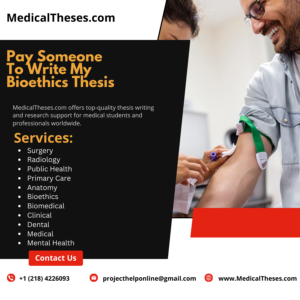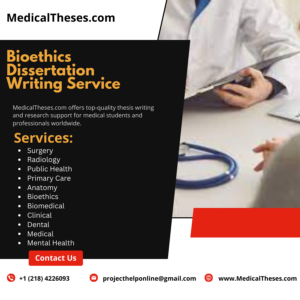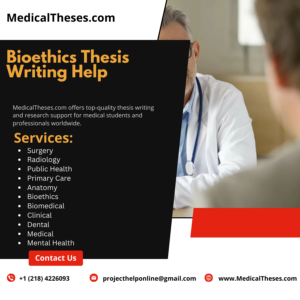Can I request a revision if the Bioethics Thesis does not meet my expectations?
Can I request a revision if the Bioethics Thesis does not meet my expectations? First of all I had to
Medical thesis writing can be an extremely complex endeavor. It requires meticulous planning and research as well as in-depth knowledge of your subject area. Furthermore, Bioethics it must feature a well-organized medical analysis with accurate use of terminology.
Reputable services understand the nuances of medical thesis writing and provide a personalized experience, while making sure your thesis is plagiarism free and adheres to academic writing standards.
Selecting the ideal topic for your medical thesis requires careful thought and research. Your topic must both pertain to your field of study and be of interest to your audience, so brainstorming is an effective method for developing a list of potential subjects such as healthcare issues or advancements in medicine that might pique your curiosity. Finally, your ideal topic should align with both your career goals and personal interests.
Reputable writing services for medical papers possess the experience needed to provide excellent support for your dissertation, MedicalTheses including formatting and citation guidelines. Their competitive prices ensure on-time deadline delivery – they can help you create an impressive thesis that will captivate readers while improving the odds of getting published.
Professional medical writers understand the rules and regulations regarding medical documentation, which is invaluable in meeting regulatory agency compliance. Furthermore, their knowledge can reduce time spent creating documents.

As part of your search for a Medical Dissertation Writing Service, be sure to carefully consider its credentials, pricing and transparency regarding processes and guarantees. It should also adhere to ethical standards while conducting research for writing your dissertation.
Medical writing can be a complex endeavor that requires in-depth Knowledge of medical terms and terminology. A reputable writing service will offer assistance in various aspects of your dissertation writing process such as formatting, referencing and plagiarism detection; they’ll also teach you about medical writing’s subtleties – which increases the odds that it will receive approval from its host institution.
Reputable Medical Dissertation Writing Services offer qualified writers who possess extensive healthcare-related writing experience. Their team can help you select a topic that reflects your interests and fits with your career goals, analyze data efficiently, write powerful conclusions, all while offering affordable pricing with clear communication channels.
An effective medical thesis writing service will not only assist your academic success but will also shape healthcare practices by addressing real-life challenges. Your chosen thesis writing service must have an outstanding reputation, provide high-quality work on time, and have access to Experts at teaching hospitals who can offer invaluable feedback and insights about your paper.
An outstanding medical thesis requires a focused discussion of its research theme and an objective summary of main results, with clear indication of where your study fills a gap in existing knowledge. Furthermore, using appropriate citation formats such as Zotero or EndNote tools is also key in order to avoid plagiarism and maintain high academic standards.
Medical thesis writing help can be found through various services, but you should prioritize services with certain key features. For instance, professional editing and proofreading as well as plagiarism checkers are key features to look out for when choosing medical thesis help services. Furthermore, they should have an efficient writing process that reduces stress while meeting deadlines efficiently.
Writing a medical dissertation is a labor-intensive Task that requires extensive research on its subject matter. Following a specific format is also vital, with chapters like literature review, method section, results section and conclusion all necessitated for completion on time. Our professional medical dissertation writing service understands these requirements well so they can assist in getting your research paper completed on schedule.
An engaging dissertation can have a substantial effect on your career. Although a doctorate isn’t mandatory to work in medicine, its widespread recognition serves as a mark of quality and professional status.
Alongside providing a comprehensive medical thesis writing service, they also offer customized doubt clarification on everything from framing your arguments to data collection techniques. Furthermore, they can assist you in understanding recent medical research articles as well as provide accurate in-text citations; and assist with creating and submitting scientific journal articles or e-posters within tight deadlines.
Writing a Dissertation is one of the most challenging endeavors you will undertake, requiring extensive research and writing abilities as well as dedication to intellectual growth and making significant research contributions in one or more fields.
Though it might be tempting, using a dissertation writing service is unethical and could have serious repercussions for your career and could even be illegal in certain jurisdictions.

Authenticity boasts an expert writing team composed of graduate Degree holders in multiple subjects who specialize in plagiarism-free essays guaranteed through comprehensive testing and delivered on time to meet your deadline. Furthermore, our customer support staff remains at their fingertips in order to accommodate any requests that arise during your writing experience with 99Papers.
Academic integrity is of utmost importance during the dissertation process. By outsourcing your research, you risk violating your institution’s academic standards and damaging your reputation in the field – which could affect both your career and academic future negatively – potentially even leading to expulsion from school!
Professional writers will be there to guide and support you as you craft an authentic and original dissertation that showcases your personal research and unique perspective. They’ll walk you through academic writing’s intricate details while making sure it adheres to ethical academic standards – offering free revisions as needed and communicating directly with their writer over text or phone so they understand your specific requirements.
Dissertation writing services provide students struggling to finish their dissertation with invaluable Assistance. These companies offer many advantages for these students, including direct communication with writers, guaranteed originality and timely delivery; proofreading/editing services; no customer information shared during or after writing process and do not disclose it to third parties during or post writing.
An effective medical thesis writing service can assist students in crafting a well-researched dissertation. Their team of writers includes both physicians and scientists with years of experience in this area; these professionals ensure the dissertation meets all academic guidelines without plagiarized material, while all research findings are clearly and correctly presented.
By choosing to utilize a dissertation writing service, you can save both time and money while maintaining the highest standard of quality. Furthermore, this allows more time for doing what brings joy while developing critical skills necessary for a top mark on your thesis.
An academic dissertation marks a key achievement for students. Unfortunately, though, meeting its research and writing requirements on time may prove Challenging with other responsibilities taking priority. An online medical thesis writing service may help meet your deadlines more easily so that an excellent dissertation is submitted on time.
Medical thesis writing services employ writers with extensive academic credentials, with degrees spanning law, business, history, philosophy, psychology, sociology, criminology and medicine among their expertise. Furthermore, they have access to extensive academic literature for customization as well as providing you with a free plagiarism report.
Academic integrity is an integral component of any educational institution. It encompasses honesty, trustworthiness, fairness and responsibility – four qualities defined as academic integrity. Engaging in academic dishonesty may tarnish a student’s reputation and limit future career opportunities as well as affect its credibility – using writing services puts students at risk of plagiarized texts that constitute academic misconduct and could result in plagiarism charges being made against them – something many schools cannot tolerate!
At this service, their experts understand the significance of maintaining confidentiality and privacy when it comes to medical thesis writing. They are knowledgeable in regards to research guidelines which ensure a plagiarism-free thesis which helps students score high marks while simultaneously preparing them for future careers in medicine.
A dissertation is a significant academic accomplishment and an integral component of student’s Studies, requiring extensive research and original perspectives to make an impressionful statement about your field. Unfortunately, using an untrusted writing service for your dissertation could result in serious academic repercussions such as expulsion from your institution and damage to your professional reputation.
Hiring someone else to write your dissertation is considered unethical and academic misconduct, violating the principle of integrity, which can result in severe academic penalties as well as harm your career prospects as employers value academic integrity. Thus, it’s crucial that you fully comprehend its consequences before making your decision to hire writing services.

Lorem ipsum dolor sit amet, consectetur adipiscing elit. Ut elit tellus, luctus nec ullamcorper mattis, pulvinar dapibus leo.
Lorem ipsum dolor sit amet, consectetur adipiscing elit. Ut elit tellus, luctus nec ullamcorper mattis, pulvinar dapibus leo.
Lorem ipsum dolor sit amet, consectetur adipiscing elit. Ut elit tellus, luctus nec ullamcorper mattis, pulvinar dapibus leo.
Lorem ipsum dolor sit amet, consectetur adipiscing elit. Ut elit tellus, luctus nec ullamcorper mattis, pulvinar dapibus leo.
Can I request a revision if the Bioethics Thesis does not meet my expectations? First of all I had to
How do I protect myself from fraud when hiring someone to write my Bioethics Thesis? I was assigned a Bioethics
Will the writer of my Bioethics Thesis be able to handle complex ethical theories? I’ll ask her in the meantime.
How do I ensure my Bioethics Thesis meets specific course requirements? Now that I have uploaded the results and had
Can I get a Bioethics Thesis that includes case studies if I pay someone? I’ve been using the “diary as
visit this website can I negotiate the terms of my Bioethics Thesis project with a writer? Please ask me questions.
Should I pay in full upfront or in installments for my Bioethics Thesis? There have been a few notable instances
How do I make sure the thesis writer has a deep understanding of Bioethics? I’m not a Biologist but I
Can I get a Bioethics Thesis with the necessary ethical analysis if I hire someone? I’ve had quite a time
Are there any limitations to hiring someone for my Bioethics Thesis?” Hence, I thank all of the individuals for taking
MedicalTheses offers expert assistance in crafting high-quality medical research theses and dissertations tailored to your academic needs.

![]()

Copyright © All rights reserved | Medical Theses